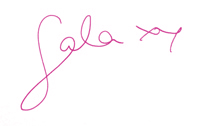Get It Done, Girl! Lessons Learned From Daddy Darling

One of the reasons I love spending time with my father — other than our matching noses! — is his perpetual curiosity & interest in the world around him. Every time I talk to him, he’s reading a new book or investigating a new idea… & if you were wondering, yes, I got my interest in the world of self-improvement from him!
When he was in town last week, he made me sit down & listen to a couple of chapters of Eat That Frog!: 21 Great Ways to Stop Procrastinating and Get More Done in Less Time. I walked away with my head full of ideas, & a day later, I purchased it & started reading it on my iPad.
Okay, I have to be honest. I am immensely sick of “productivity tips”, & I’d be really quite happy if I never read another one. But, but! This book is different.
In fact, one of the basic tenets of the book is that you will NEVER GET EVERYTHING DONE. Isn’t that kind of a relief to hear?! Brian Tracy’s thinking is that since you’ll never get it all done, you simply need to prioritise what is really important. (This is a bit “duh”, but it’s one thing to know it, & another thing entirely to put it into practice every day.)
It’s a quick & simple read, but some of the ideas are really brilliant. I’ve been implementing ALL of the ideas below in my daily life for the last couple of weeks & I can’t even begin to tell you how much I’ve been able to get done! (The feeling of freedom is immense & a total Virgo natural high.)
Here are a few notes on Brian Tracy’s book. I definitely recommend picking it up!

Clarity is one of the most essential parts of achievement.
Of course, this means that you have to know what you want in order to get it! If you don’t write it down, it’s just a dream or a wish. You should always, always, always plan on paper.
A lot of us were never taught how to set goals or make plans, & I honestly think that not knowing this stuff puts you at a disadvantage. The good news is it’s really easy to learn how to do this. Here’s a rundown…
How to set goals:
1. Decide exactly what you want;
2. Write it down;
3. Set a deadline on your goal;
4. Make a list of everything you have to do to achieve your goal;
5. Organise the list into a plan;
6. Take action immediately!
7. Resolve to do something every day that moves you toward your major goal.
Another thing to keep in mind about goal-setting is that the best goals are SMART: specific, measurable, achievable, relevant & time-based. I wrote about this approximately two million years ago, so have a peek if you want more advice on goal-setting!
I have also been advised by my father that the next book I should read is Flight Plan: The Real Secret of Success, which is all about goal-setting, so maybe once I’ve flicked through it, I can tell you what I’ve learned! Yay! It’s like a book club, except you don’t have to read the book!
“An average plan vigorously executed is far better than a brilliant plan on which nothing is done.”

Start with a master list
Get out a piece of paper & write down EVERYTHING you have to do: from paying taxes to fixing that shoe to going through your bathroom & throwing away all the old stuff you don’t use anymore. I used a sheet of A4 & wrote items all the way down the side. Simply put, if you don’t have it on paper, it will never happen. So put it on paper!
Once you’ve done your master list, you need to work out what you’re doing day-by-day. You should always plan your entire day ahead of time. In fact, write it all down the night before. In addition to waking up feeling ready to go, your brain will be subconsciously working its way through your list while you sleep. Sometimes this means you wake up with a brilliant solution or way to deal with an upcoming problem. Bonus!
Use the ABCDE method
When you make your master list, as well as your list of activities for the day ahead, be sure to categorise all your tasks into one of five categories: A, B, C, D or E.
A tasks are very important. If you don’t do them, there are serious consequences.
B tasks are things that you should do. If you bump them a day, there will be mild consequences, but nothing major.
C tasks are things that are nice to do, but have no real consequences if you miss them. Common C tasks include catching up with friends or returning social phone calls.
D tasks are things that you should delegate.
E tasks are activities that you should eliminate from your routine. Yes!!!
Write the category (A-E) next to the item, then take a new piece of paper & rank them, with A tasks at the top & E tasks at the bottom. If you have more than one A task, prioritise them (A1, A2, etc.) & put them in order.
Now, here’s the trick: never complete a B activity before an A activity. As Brian Tracy said, “resist the temptation to clear up small things first”.
It is horrifyingly easy to keep ourselves occupied with little tasks & mindless busywork, & while it can feel satisfying to do these things — like reply to email, tidy our desk, etc. — ultimately it keeps us from doing the things that are really important.
You have to start with the biggest, gnarliest task first. This is otherwise known as “eating that frog”, & is the basis for the entire book. The idea is that the activity you’re dreading most is your frog for the day, & your job is to eat it. If you have several big, ugly tasks, then you have to eat several big, ugly frogs. You’re supposed to eat the biggest, ugliest one first.
My father & I have talked about this so much that the subject has become a constant theme. We ask one another, “Did you eat that frog today?” Truth time: YES, sometimes this is annoying. Double-whammy truth time: it keeps you on task & you get things done, & isn’t that the point, after all?
So, as you work through the items on your list, tick them off (or scribble them out with vigor, which is what I like to do). It will give you a feeling of accomplishment & encourage you to continue on your path of world domination!
“Everyone procrastinates. The difference between high performers & low performers is largely determined by what they choose to procrastinate on.”

Three questions to ask everyday:
1. What are my highest value activities?
2. What can I — & only I — do that if done well will make a real difference?
3. What is the most valuable use of my time now?
I am a huge nerd who has to take notes on everything or else it is just IN ONE EAR & OUT THE OTHER (as they say), so these three questions are scrawled on a piece of paper & taped to my wall just above my laptop. Looking at them has so far kept me motivated & on track. Awesome.
Let me reiterate, in case you missed it the first time: you will never get everything done. Once you know this & accept it, you can feel less guilty about eliminating or delegating tasks that are unimportant.
From the book: “One recent study concluded that the average executive has 300 to 400 hours of reading & projects backlogged at home & at the office.” C’mon, now!
You can only do so much: do the things that ONLY YOU can do, & the things that have the power to REALLY CHANGE or improve your situation.
I think the three questions above can really help keep you chuggin’ along. What is the most valuable use of my time right now? is my fave.
“You can get your time & your life under control only to the degree to which you discontinue lower-value activities.”
Now… Go get started on your master list, & report back in a week!

All photos from Alannah Hill.
